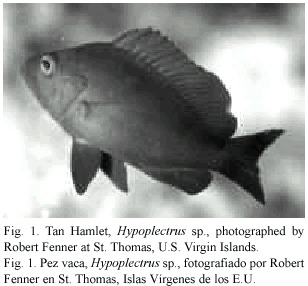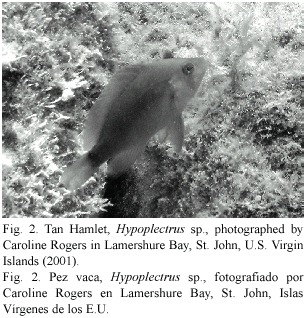Services on Demand
Journal
Article
Indicators
-
 Cited by SciELO
Cited by SciELO -
 Access statistics
Access statistics
Related links
-
 Similars in
SciELO
Similars in
SciELO  uBio
uBio
Share
Revista de Biología Tropical
On-line version ISSN 0034-7744Print version ISSN 0034-7744
Rev. biol. trop vol.54 suppl.3 San José Dec. 2006
New geographic records of Hamlets, Hypoplectrus spp. (Serranidae), in the Caribbean Sea
Ernest H. Williams, Jr.1*, Lucy Bunkley-Williams2, Caroline S. Rogers3 & Robert Fenner4
1 Department of Marine Sciences, University of Puerto Rico, P.O. Box 9013, Mayagüez, Puerto Rico 00667; 1 Department of Marine Sciences, University of Puerto Rico, P.O. Box 9013, Mayagüez, Puerto Rico 00667; telephones: office/message (787) 832-4040 x 1725, fax: 787-265-3838; ewilliams@uprm.edu
2 Caribbean Aquatic Animal Health Project, Department of Biology, University of Puerto Rico, P.O. Box 9012, Mayagüez, Puerto Rico 00861; lwilliams@uprm.edu
3 Virgin Islands National Park, U.S. Geological Survey, Biological Resources Division, Florida Caribbean Science Center, P.O. Box 710, St. John, US Virgin Islands 00830; caroline_rogers@usgs.gov
4 Web Web Media, 8586 Menkar Road, San Diego, California, USA 92126; BobFenner@WetWebMedia.com
* Correspondence
Received 01-VI-2006. Corrected 02-X-2006. Accepted 13-X-2006.
Abstract: The exact number of species of hamlets, Hypoplectrus spp., in the Caribbean is controversial and the geographic distributions of these species/forms are poorly documented. We report Curaçao, Netherlands Antilles, as a new locality for the Barred Hamlet, H. puella (Cuvier), and Shy Hamlet, H. guttavarius (Poey); and St. John and St. Thomas, U.S. Virgin Islands, for the Tan Hamlet, Hypoplectrus sp. The Black Hamlet, H. nigricans (Poey), has previously been reported from Curaçao, but we did not see it there. Rev. Biol. Trop. 54 (Suppl. 3): 171-173. Epub 2007 Jan. 15.
Key words: Hamlets, geographic distribution, Curaçao, U.S. Virgin Islands, Hypoplectrus spp.
Hamlets (Hypoplectrus spp.) are either 10 to 12 species, a single species, or some number in between, of tiny, dull to brightly colored Caribbean coral-reef grouper(s) (Serranidae). They are too small to be of value as human food, too aggressive to be much use as aquarium fishes, and would be pretty much ignored if not for the controversy over the number of species that exist and some of their interesting mimicry (Domeier 1994, Humann 1994, 2002, Aguilar-Perera 2003). Although some species are very popular photographic subjects for sport divers (e.g., Golden Hamlet, H. gummiguttta) and most species/variants are relatively easy to identify in the field, their distributions remain confused and poorly documented.
On 10 June 2002 using SCUBA, we observed numerous 8-12 cm TL specimens of Tan Hamlet, Hypoplectrus sp., an undescribed species/variant, in 8-16 m depth on an approximately 45º seaward slope of a rock ridge sparsely covered with largely dead, low-profile stony corals off Whistling Key, St. John, U. S. Virgin Islands, 18°22.1N, 64°45.3W. An atypical specimen of Butter Hamlet, Hypoplectrus unicolor, also occurred on this reef (Williams and Bunkley-Williams 2005, 2006). The Tan Hamlet had not been previously reported from any of the U.S. Virgin Islands (Domeier 1994, Humann 1994, Aguilar-Perera 2003, in press); although, Humann (2002) reported it from the Virgin Islands in general, with no specific locality, and Fenner (no date) photographed a specimen in St. Thomas, USVI (Fig. 1) below.

After Williams and Bunkley-Williams (2005) was presented in Curaçao, Caroline Rogers (unpubl. data.) informed EHW about a photograph of a Tan Hamlet she had recently taken in Lamershure Bay, St. John, U.S. Virgin Islands, 18°19.2N, 64°43.6W (Fig. 2);and we learned from Robert Fenner (unpubl. data) that he took his photograph in 2001 in Water Bay, St. Thomas, U. S. Virgin Islands,18 °20.6 N, 64°51.6W. Thus we establish new geographic records for the Tan Hamlet in St. John and St. Thomas.
During SCUBA dives in Curaçao (Williams and Bunkley-Williams 2005, 2006), 12 Yellowtail Hamlets, Hypoplectrus chlorurus (Cuvier); three Barred Hamlets, H. puella (Cuvier); one Shy Hamlet, H. guttavarius (Poey); and one hybrid between a Butter Hamlet and a Barred Hamlet were observed. The Barred Hamlet and Shy Hamlet have not been previously reported from Curaçao. Smith (1997) reported the Black Hamlet, H. nigricans (Poey), from Curaçao, but we did not observe that species/variant. Pattengill-Semmens (2002) reported the Tan Hamlet from Bonaire, Netherlands Antilles; however, this was based on the observation of a non-professional.
Acknowledgments
We thank Steven Piontek, Curaçao Sea Aquarium, Bapor, Curaçao, for assistance in diving; Emma, Jessie, Dolph and Helen Bunkley, Santa Fe, New Mexico, and Len and Michelle Amato, Virgin Islands registry trimaran Opus, St. Thomas, USVI, for field assistance in the Virgin Islands. Partial support was provided by Sportfish Restoration Funds, Wallop-Braux Project F-28-13.
Resumen
En el Caribe, el número exacto de especies de pez vaca, Hypoplectrus spp., es controversial y la distribución geográfica de estas especies/variedades está pobremente documentada. Presentamos Curaçao, Antillas Holandesas, como nueva localidad para el pez vaca de barras, H. puella (Cuvier) y el vaca bicolor, H. guttavarius (Poey). Agregamos St. John y St. Thomas, Islas Vírgenes de los EUA, al ámbito del "Tan Hamlet", Hypoplectrus sp. Anteriormente se dijo que en Curaçao se halla el pez vaca negra, H. nigricans (Poey), pero no lo vimos en nuestros muestreos.
Palabras clave: pez vaca, distribución geográfica, Curaçao, Islas Vírgenes, Hypoplectrus spp.
References
Aguilar-Perera, A. 2003. Abundance and distribution of hamlets (Teleostis: Hypoplectrus) in coral reefs off southwestern Puerto Rico: Support for the multispecies hypothesis. Carib. J. Sci. 39: 147-151. [ Links ]
Aguilar-Perera, A. in press. Distribution of Hypoplectrus (Teleostei: Serranidae) in the Wider Caribbean Region. J. Biogeogr. [ Links ]
Domeier, M. L. 1994. Speciation in the serranid fish Hypoplectrus. Bull. Mar. Sci. 54: 103-141. [ Links ]
Humann, P. 1994. Reef fish identification: Florida, Caribbean, Bahamas. New World, Jacksonville, Florida, USA. 424 p. [ Links ]
Humann, P. 2002. Reef fish identification: Florida, Caribbean, Bahamas. New World, Jacksonville, Florida, USA. 512 p. [ Links ]
Pattengill-Semmens, C. V. 2002. The reef fish assemblage of Bonaire Marine Park: An analysis of REEF fish survey data. Proc. 53rd Gulf Carib. Fish. Inst. 53: 591-605. [ Links ]
Smith, C. L. 1997. National Audubon Society field guide to tropical marine fishes of the Caribbean, the Gulf of Mexico, Florida, the Bahamas, and Bermuda. Alfred A. Knopf, New York, USA. 720 p. [ Links ]
Williams, E. H., Jr. & L. Bunkley-Williams. 2005. Rock Beauty crown pattern, grackle scythebill, and Butter Hamlet double spot anomalies, and their possible genetic significance. Proc. Assoc. Mar. Lab. Carib. 32: 57 (abstract). [ Links ]
Williams, E. H., Jr. & L. Bunkley-Williams. 2006. Grackle scythebill, Rock Beauty crown pattern, and Butter Hamlet double spot anomalies, and their possible genetic significance. Rev. Biol. Trop. 54 (Suppl. 3): 161-169. [ Links ]
Internet reference
Fenner, R. no date. The basses called hamlets, genus Hypoplectrus. Wet Web Media.com (Downloaded:2 July 2005,http://www.wetmedia.com/Hypoplec.htm). [ Links ]















